ARMENII DIN IMPERIUL OTOMAN ȘI IDEEA DE NAȚIUNE
ARMENIANS IN THE OTTOMAN EMPIRE AND THE IDEA OF NATION
Author(s): Remus TanasăSubject(s): History, Ethnohistory, Social history, 19th Century, The Ottoman Empire, Ethnic Minorities Studies
Published by: Editura Academiei Române
Keywords: nationality; Eastern Anatolia; kurds; Armenian Question; reform;
Summary/Abstract: In the 19th century and late Ottoman Empire, the “millet” was a religious community with its own hierarchy and with political and economic influence within the Empire, being the result of an administrative necessity. The “millet” system was the way in which the Ottoman sultans were able to rule over a contrasting empire, by ensuring both inter-ethnic and inter-religious cohabitation; also, the practice incorporated some religious groups into the Ottoman state while allowing them to keep their religious faith, culture and administrative autonomy. For the Ottoman Armenians, the change of course from the “millet” system towards self-determination arose following a series of social and economic changes caused mainly by the Sultans’ slithery approach to authority and towards the partnership between the state and what today we might call civil society. Likewise, the “Armenian Question” and the development of the idea of nation would have developed differently if the Armenians would have got better protection in Eastern Anatolia from the authorities, where they were competing over land and resources with the Kurdish tribes.
Journal: Anuarul Institutului de Istorie »A.D. Xenopol« - Iaşi
- Issue Year: LVIII/2021
- Issue No: 58
- Page Range: 67-76
- Page Count: 10
- Language: Romanian

